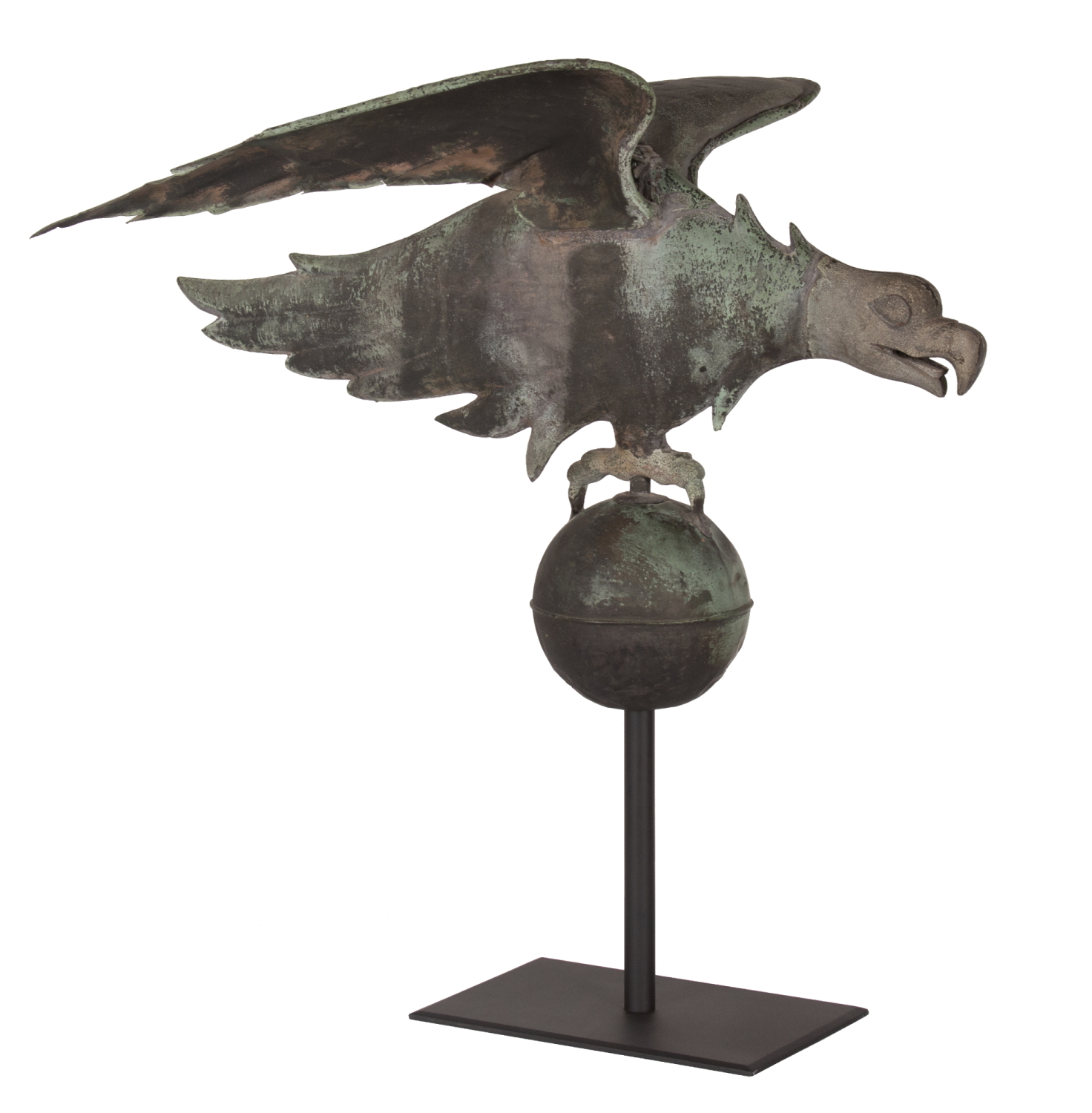
| |
EAGLE WEATHERVANE IN A BEAUTIFUL FORM WITH GREAT FOLK PRESENCE, POSSIBLY MADE BY A.L. JEWELL & CO. (1852-1867) OR ITS PREDECESSOR, CUSHING & WHITE / L.W. CUSHING (1867-1870’s), WALTHAM, MASSACHUSETTS |
| |
|
| Dimensions (inches): |
27" tall x 27.5" wide x 14.75" deep |
| Description: |
|
Eagle weathervane, made of hammered copper with a cast zinc head and talons, in a beautifully stylized, war-like form. The narrow, hollow body form is comprised of two mirror image sides, in typical fashion, with single sheet copper wings applied, bent as if poised for takeoff. With beak open and a curved tongue, the majestic bird is positioned as if perched on the copper ball beneath.
This basic form is universally attributed to A.L. Jewell & Co. of Waltham, Massachusetts, active 1852-1867, and known to have been produced in five sizes, measuring between 17 and 51 inches in length (Massachusetts Capital development Fund, Annual Report, 1979). According to American folk art expert Bob Bishop and co-author Patricia Coblentz (A Gallery of American Weathervanes & Whirleygigs, 1984 edition, Bonanza Books / Crown Publishers, p. 51), a similar form, slightly downward-facing, is known to have been produced in the 3rd quarter of the 19th century by Boston Metal-Workers Company.
The reality is that weathervane makers copied one-another extensively and maker’s marks were in no way standard practice. Of the three similar examples illustrated in weathervane reference text, two by Bishop & Coblentz (p. 50 & 51) and one by Charles Klamkin (Weathervanes, 1973, Hawthorne Books, New York, p. 88), none are alike. Two appear to be slightly downward-facing, yet two are attributed to A.L. Jewell and one to Boston Metal-Workers Co. The basic design is one that I have occasionally encountered over many years in the antiques trade, usually attributed to Jewell, who, if nothing else, can at least be said to have probably come up with the original design. Jewell was in on the ground floor of commercial weathervane production. This was a transitional period, bridging the gap between when weathervanes were largely singular and bench-made by anyone that could, during the first half of the 19th century and prior, and the emergence of large firms that mass-produced in the last quarter of the 19th century and afterwards. Jewell pioneered that field. In 1867, when Jewell and a business associate were killed in a work-related accident, the firm was acquired by Leonard Cushing, a civil engineer from Providence, Rhode Island, and Stillman White, a machinist. Both were of Waltham originally and took the opportunity to return. White left the company not long after and L.W. Cushing became the new name in 1872. While I have not encountered the form attributed to Cushing & White or featured in Cushing catalogues, it is certainly conceivable that the form continued to be produced, as the two men bought the designs with the business.
I previously acquired and sold a similar vane in this form, in another slight variant from the illustrated examples, with a cast iron head and talons. The one I am offering here is, yet again, not precisely like any of the above. The feathers differ slightly, as does the cast head, in zinc. Some have a hollow head, formed as simply an extension of the body, in molded copper.
Past the beautiful form, the most wonderful thing about this weathervane is its tremendous, early, weathered surface. Note the combination of green verdigris and black oxidation. All-in-all, a visually compelling bird with just the sort of legitimate patina that connoisseurs of early weathervanes hope to find.
Condition: Past the aforementioned verdigris and oxidation, there are a few minor breaks and bends in the wings. The ball was dented. I was able to work the ball back into its proper, spherical shape, from the interior. In doing so I created some surface loss on the exterior, mostly where creases were reversed. When this occurred, I applied a bit of black pigment to restore the immediately previous state of appearance. |
|
|
| |
|
| Primary Color: |
green, black |
|
| Earliest Date: |
1852 |
|
| Latest Date: |
1870's |
|
| For Sale Status: |
Available |
|
| Price |
$25,000 |
|
| E-mail: |
info@jeffbridgman.com |
|
 |
|
Page Views:... 2593 |
|


